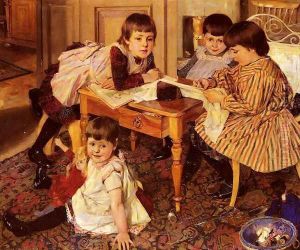Gustav Oskar Bjorck Paintings
Gustav Oskar Björck was a Swedish painter and illustrator who was born on December 15, 1860, in Västra Klagstorp, Sweden, and died on January 21, 1929, in Stockholm. His artistic career spanned the late 19th and early 20th centuries, a period in which Swedish art was undergoing significant changes, with artists seeking new forms of expression and exploring various styles.
Björck studied at the Royal Swedish Academy of Arts in Stockholm, an institution that played a central role in the education of many Swedish artists of the time. During his studies, Björck honed his skills in drawing, painting, and composition, and he was influenced by the prevailing academic art standards, which emphasized classical subject matter, realistic portrayal, and technical precision.
After completing his education, Björck traveled to France, like many artists of his generation, to further his studies and to immerse himself in the vibrant art scene of Paris. This experience exposed him to new artistic movements and styles, such as Impressionism, which were emerging in France and other parts of Europe. Björck was particularly drawn to the Impressionist focus on capturing light and atmosphere, which he incorporated into his own work.
Upon returning to Sweden, Björck worked as a portrait painter and illustrator, capturing the likeness of many notable figures of his time. He developed a reputation for his skilled brushwork and ability to render his subjects with a sense of personality and depth. Along with portraiture, Björck painted landscapes and genre scenes that often depicted the Swedish countryside and its inhabitants. These works are characterized by their naturalistic style and sensitivity to the changing qualities of light and atmosphere, demonstrating the influence of his exposure to Impressionism.
Throughout his career, Björck exhibited his works at various art shows, including the Paris Salon, and he was recognized by his peers and critics for his contributions to Swedish art. His illustrations appeared in several publications, further cementing his reputation as a versatile and talented artist.
Gustav Oskar Björck's legacy is preserved in the collections of various Swedish museums, where his paintings continue to be appreciated for their beauty, craftsmanship, and historical value. His art provides a window into the artistic transitions of his time and reflects the cultural and social milieu of late 19th-century and early 20th-century Sweden.
